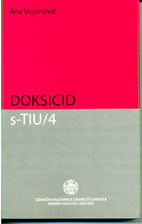Ana Vujanovic, Doxicid; A fundamental mapping of contemporary theories of performing arts (DOKSICID s-tiu/4; fundamentalno mapiranje savremenih teorija izvođačkih umetnosti), Sremski Karlovci – Novi Sad: IKZS, 2007
(in Serbo-Croation language)
A Tiger’s Leap into Past (2007-2009)
Artistic research on evacuated genealogies of dance, by Ana Vujanović and Saša Asentić
It is an artistic research dedicated to the articulation of the past of the local dance scene in historical terms.
Co-authors: Ana Vujanović & Saša Asentić
Producer: Per.Art, Novi Sad.
Video-materials: Dragana B. Stevanović, Marta Popivoda, Saša Asentić
”Tigrovski skok kao način istorizacije je bazična metodologija istraživanja domaće plesne scene kroz 20.vek, predstavljenog ovom video instalacijom.
Osnovna referenca nam je Benjaminov poslednji tekst Istorijsko-filozofske teze, prema kojem: “Istorijski artikulisati prošlost ne znači spoznati je ‘kakva je, u stvari, bila’. To znači ovladati sećanjem onako kako blesne u trenutku opasnosti”. Ključna reč Benjaminove zamisli istorije je nem. Eingedenken, što je ovde prevedeno sa ‘sećanje’. Žižek, međutim, u Sublimnom objektu ideologije napominje da “ne možemo ovo Eingedenken prevesti jednostavno sa ‘sećanje’ ili ‘reminiscencija’; i doslovniji prevod kao ‘preneti sebe u mislima/u nešto’ takođe je neprimeren”, jer kod Benjamina Eingedenken je interesno prisvajanje prošlosti. Tako se plesna prošlost koju nudimo pretežno i sastoji od specifičnih sećanja intervjuisanih, koji sad-i-ovde ispisuju tamo-i-onda, ne teleološki već u jednoj slaboj genealogiji, koja je evakuisana iz zvanične istorije savremene plesne scene u evropskim i globalnim okvirima.
